Septic tank for high groundwater: methods for determining the water level and recommendations for choosing a septic tank
In the private sector, there are frequent situations when there is a centralized water supply system, and there is no sewage. In order to use all the necessary plumbing fixtures without problems, you need to take care of water disposal and wastewater treatment.
The task is complicated if the aquifers are close to the surface. A septic tank for high groundwater can become a solution to the problem - the device is selected based on an assessment of the geological condition of the site and the estimated intensity of operation.
The content of the article:
Purpose and features of the septic tank
A well-maintained private house is a lot of plumbing and household appliances that consume water: toilet, kitchen sink, wash basin, bath or shower, washing machine. Often also installed dishwashers.
The use of all this equipment generates a large amount of wastewater.
For the disposal of effluents, the owner of the house needs to consider an effective sewage system. Good old cesspool is not an option, becauseeven the largest sealed tank will often have to be cleaned, and this is a serious cost for sewage services
Wastewater should be disposed of, without harming the environment, and the best choice is a septic tank that provides biological treatment for contamination.
The purpose of the septic tank is the accumulation, purification and disposal of effluents. This process occurs in stages in several (usually two or three) chambers.
The first tank is designed to collect wastewater from the sewer system. Here, the primary treatment takes place: the effluents are stratified, solid particles sink to the bottom, and clarified water with fewer impurities flows into the next chamber.
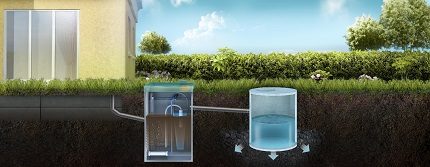
In the second tank, the process of fermentation of sewage continues. Anaerobic bacteria decompose organic compounds, and waste water continues to be purified. Almost pure water enters the third chamber, the filtration field or the above-ground filter cassette, where post-treatment takes place.
What problems arise due to high GW?
If ground water is located close, the septic tank should be absolutely tight, and its installation should be perfectly correct. Otherwise, two types of malfunctions can occur: the structure will pop up or flood it. We will understand what this threatens.
When installing a septic tank, it is carefully mounted on a concrete pad. If this is not done, during the period of high water or showers, it will rise to the surface of the soil. This will inevitably lead to deformation of the elements of the sewer system, pipe breaks and other troubles. Sewerage will fail.
If an insufficiently reliable septic tank is selected or built for the installation of water treatment, sooner or later groundwater will begin to seep into the structure. This will lead to its flooding. A full tank will stop working normally. But that is not all.
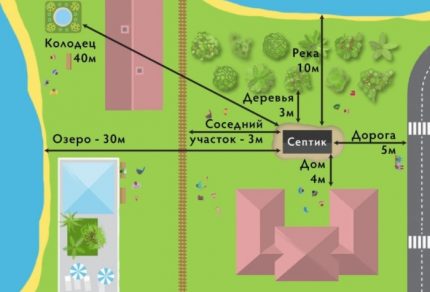
Water may begin to flow into the system through a pipeline. This is fraught with pipe breaks, flooding of the foundations of buildings. In some cases, water from a flooded septic tank rises to plumbing fixtures in the house and causes serious damage.
Flowing through pipes, water carries a lot of impurities - from sewage from septic tanks to solid particles (sand, pebbles, garbage). Its chemical composition is extremely aggressive. This can provoke corrosion of metal elements, violation of the integrity of the coatings of pipes and plumbing equipment, mechanical damage.
All this leads to the rapid destruction of the septic tank and all elements of the sewer system. That is why with a high level of water supply it is impossible to save on materials and installation. The stronger and hermetic the design, the longer the trouble-free operation.
Sewer drains are cleaned by a large number of microorganisms. If sewage seeps into the aquifer on which wells and boreholes are built, this can result in intestinal (at best) diseases for people, diseases of domestic animals.
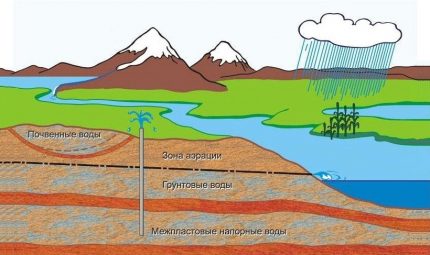
High groundwater is not only a risk of accidents, but also a large investment of money, especially if installation errors are made. Depressurization will lead to the fact that water will seep into the tank, and it will need to be pumped out more often. The costs of sewage services will increase sharply.
Another caveat: when designing an autonomous sewage system, it is necessary to immediately think over the drainage system on the site, otherwise the swamping of the area around the septic tank is not ruled out.
Determination of groundwater depth at the site
The ideal option is the determination of GWV using hydrogeological studies. However, professionals are rarely addressed, because it is expensive, long and difficult. You can navigate on your own, and the usual garden drill or folk signs will help.
Option # 1: garden drill and rod
To determine the groundwater level, a drill and a rod from 2 m long are suitable. On the rod, it is necessary to make notes under the tape measure. It is not necessary to mark every centimeter, enough marks at a distance of 5-10 cm.
It is necessary to make a well the length of the drill. It happens that the water comes out while drilling. This means that it is very close to the surface. However, more often you have to wait. The well is left for a day so that water accumulates in it.
Dry rod is lowered to the bottom of the well. Then they take it out and check to what level it gets wet. It remains only to calculate the results. For example, if the length of the drill is 2 m, and 10 cm of the rod is wet, it turns out that the water lies at a depth of 1.9 m.

Such measurements are carried out not once, but over several days, each time recording the results. If they do not change, then it is at this depth that water is located. If there is a difference, then you should focus on the smallest results. For example, if a depth of 1.9 m and 1.8 m is obtained on different days, then 1.8 m is considered to be the correct water level.
Option # 2: determined by plants
Often an indicator of the close occurrence of water is vegetation. For example, if a willow, an alder, a leafy meadowsweet, and especially a reed grow on the plot, then the soil is moist. You can determine the depth in meters from plants using the table below:
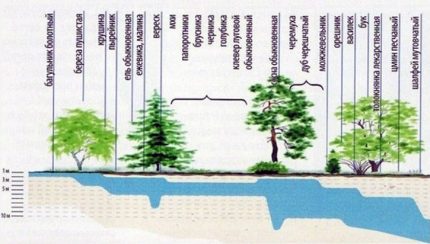
The slope of maple, birch, willow may indicate where exactly the water comes closest to the surface. It is best to navigate through several trees at once.
Option # 3: ponds and wells
Often near the site there are small open ponds. By the water level in them, you can determine how closely the aquifer fits. If there are swamps, this is a sure sign of high GW.
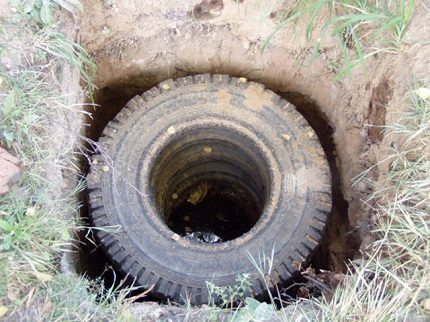
In determining the depth of groundwater, regular communication with neighbors can also help, because they probably had to determine it in the process of building houses, household buildings, hydraulic structures, sewers.
Option # 4: grandfather ways
It is possible to determine the GWV using a conventional clay pot. To do this, remove sod from a small plot of land, lay a shred of skim wool, on top - a freshly laid egg. All this is covered with ceramic dishes and left overnight.
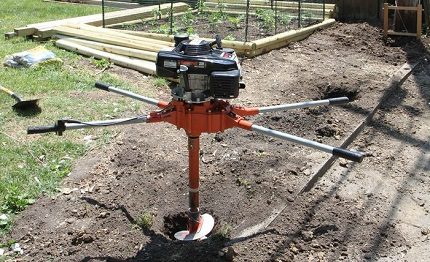
In the morning, it is enough to inspect the wool and the egg. If the coat is wet, but there is no sign of condensation on the egg, the GWA is low. If the coat is wet, and there are droplets of moisture on the egg, then the water clearly comes very close to the surface.
Option # 5: folk signs
Conventional observations can also be useful in determining the GWL. For example, abundant morning dew and dense evening fog indicate the proximity of water to the surface of the soil. The closer the aquifer, the more obvious these signs. They can be observed even in extreme heat and drought.

Pets behave differently depending on the depth of the water. For example, cats can choose a place to rest where water is close. And dogs, on the contrary, are looking for the driest place on the site.
For all the shortcomings of a high GW, there is a big plus. Rodents avoid places with high humidity. So, you will be less attacked by mice. Ants also behave in the same way. The absence of anthills on the site may indicate high soil moisture.
The correct septic tank in the area with high GW
In some cases, it makes sense to install a sealed storage tank. This is a kind of analogue of a cesspool. Its peculiarity is that the liquid only accumulates in the tank, but is not cleaned.
Cons - the need for frequent maintenance and high cost. On the other hand, if the house does not reside permanently, such a sewer will be beneficial and convenient.
Accumulative septic tanks of industrial production are made of high-strength materials. The wall thickness of the tank can reach 10-40 mm. There are large volume septic tanks.
Their advantages:
- absolute tightness;
- environmental safety;
- ease of installation;
- durability.
Some models are equipped with sensors indicating the degree of capacity filling.

In most cases, the drive does not solve the problem, because for a comfortable life, home owners need a full sewer. In this case, it makes sense to equip a septic tank with a bulk field of aeration. The design must be waterproof. It must be protected from ascent, deformation due to soil heaving.
Features of materials for the manufacture of cameras
There are several suitable materials for equipping a septic tank with high groundwater:
- Reinforced concrete. Volumetric monolithic reinforced concrete structure - An ideal option for a home where a family of 3 or more lives. The cameras of such a septic tank do not let water through, do not float, cope with the effects of aggressive chemicals and can serve for decades.
- Plastic (containers or eurocubes). Not the most reliable material, but it is suitable for independent arrangement of a septic tank in the country. Pros - tightness, lightness. Cons - the need to equip good protection against ascent, the risk of cracks during heaving of the soil.
- Fiberglass. The material is characterized by high strength, lightness, withstands heavy loads, tolerates the effects of chemicals. The disadvantage is the same as that of plastic: a septic tank must be anchored during installation.
To equip a reliable sewage system, it is best to choose reinforced concrete. The construction of such a septic tank will be quite expensive, but you can forget about the problem of ascent.
The structure will not burst if transport accidentally hits it, as might happen with a plastic or fiberglass tank. It is extremely durable and repairable.
Protection of a septic tank against ascent and soil heaving
Light plastic septic tanks must be fixed, as their weight is not enough to withstand the pressure of groundwater. They often pop up. The technology of anchoring the structure itself is simple, the main thing is to strictly adhere to it.
Work order:
- The bottom of the pit is level. A sand cushion 30 cm thick is poured on top, carefully tamped.
- Put a foundation on a layer of sand - a reinforced concrete slab according to the size of the structure.
- Septic tank mounted on a stovesecuring with special straps or cables.
To protect against soil heaving, use a dry mixture of sand and cement (5: 1). After installing the septic tank, a gap remains between the structure body and the walls of the pit.
It is desirable that it be at least 15 cm. The mixture is poured into layers in this space, pouring water and compacting each layer.

During backfill, the septic tank is simultaneously filled with water. Moreover, the water level should coincide with the level of filling the pit. This is necessary to even out the load and prevent cracking in the plastic structure.
The device of the above-ground filter cartridge
If the groundwater is deep, for the treatment of sewage equip either filter fieldeither filter well. In this case, the water moves by gravity, there is no need for forced pumping.
If the water level is high, you need to install an additional waterproof well, pump and filter cartridge. Its size is calculated based on the fact that for cleaning 0.5 cubic meters. need a cassette 1 x 1 m.
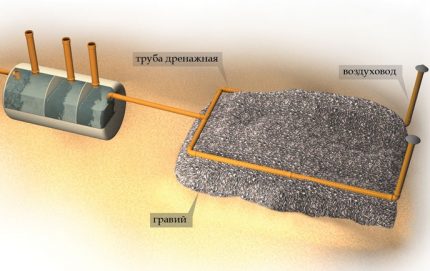
To equip the filter cassette, 30-40 cm of soil is removed over the entire surface of the future structure, and the perimeter is enclosed with concrete blocks so that they are level with the ground in height.
This space is covered with rubble (fraction from 20 to 40 mm), and a tank without a bottom is placed on top, under which a pipe from the septic tank is brought. The structure is insulated and covered with a layer of soil with a thickness of 30 cm.
TOP 10 best septic tank manufacturers
If groundwater lies close to the surface, you can choose a septic tank for industrial production. It is guaranteed to be airtight, the rest depends on the quality of installation.
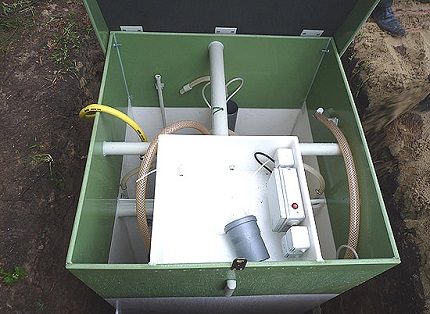
There are several brands that have proven themselves in the domestic market:
- "Tank". These are plastic non-volatile structures with a wall thickness of the case up to 17 mm. They withstand loads well, are resistant to temperature extremes. The design is thought out so that the tank does not float under the influence of groundwater.
- "Triton". Under this brand, septic tanks of various sizes and purposes are produced. When installing the model you need to anchor. If they are mounted correctly, they can last up to half a century.
- "Leopard". The manufacturer produces volatile and independent models. These are three-chamber septic tanks with two levels of biological filtration. Designs are reliable, strong, durable.
- Tver. These are reliable integrated wastewater treatment systems. The advantages of septic tanks include compactness, strength, high throughput. The disadvantage is volatility and the need for appropriate maintenance.
- "Leader". Septic tanks consist of six cameras for various purposes. The designs include airlift and aerator. Plus: you do not need to use bioadditives for the normal operation of the installation. The system is designed perfectly.
- Ecopan. One of the best options for installation in clay and heaving soils with high groundwater level. The design is designed so that it can withstand heavy loads without the slightest damage and deformation.
- Unilos. Phased mechanical and biological treatment ensures the safety of the septic tank for the environment. The constructions are reliable and easy to maintain, despite the complex algorithm of the wastewater treatment process.
- Yubas. These septic tanks are not only reliable and durable. They are distinguished by one more advantage: the designs do not lose in operability and efficiency, even if they are operated with long interruptions (up to 3 months).
- Topas. “Topas” autonomous sewage systems are in demand due to their reliability.Although the principle of their work is the same as that of the other septic tanks, the manufacturer took care of the high quality of materials for the manufacture of their products.
When choosing a specific model of any brand, you should check with the seller all the details. Septic tank must be durable and strong.
In addition, the installation should purify waste water as efficiently as possible and be easy to operate.
When buying a model, pay attention to energy consumption and the required frequency of cleaning. It is also important how long the septic tank remains operational in the event of a power outage and how quickly it returns to standard operating mode.
Conclusions and useful video on the topic
Close occurrence of groundwater can create many problems in the construction of autonomous sewage. We offer useful videos in which you will find many tips and you can design and build a system without the help of specialists.
Description of the features of sewerage at high water level and detailed explanations of the owner of the site:
Earthworks and septic tank installation process - demonstration:
Useful recommendations for building a sewer with your own hands and a visual demonstration of the process.
Part 1:
Part 2:
The quality of the design and installation of the sewer system determines the comfort of the residents of the house. If the site has a high level of groundwater, you should carefully study the installation technology of the septic tank and select the correct model. Otherwise, problems are inevitable.
Doubt your strength - invite experts. This will be much cheaper than reworking an inefficient sewer system later.
If you have experience using a septic tank, please share the information with our readers. Tell us which model you have chosen? Leave comments and ask questions on the topic in the form below.

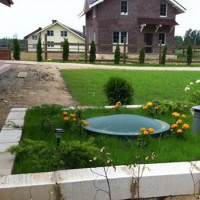 How to choose a septic tank for giving: an overview and tips for choosing the best option
How to choose a septic tank for giving: an overview and tips for choosing the best option 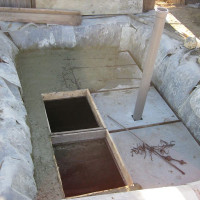 Do-it-yourself monolithic concrete septic tank: schemes and rules for arranging a concrete septic tank
Do-it-yourself monolithic concrete septic tank: schemes and rules for arranging a concrete septic tank  How is septic tank preservation for the winter: step-by-step instructions
How is septic tank preservation for the winter: step-by-step instructions 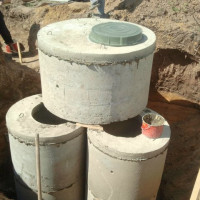 Do-it-yourself septic tank without pumping and odor: simple solutions for your garden
Do-it-yourself septic tank without pumping and odor: simple solutions for your garden 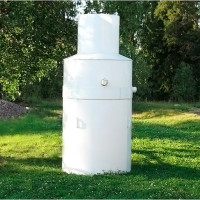 Overview of the cedar septic tank: device, principle of operation, advantages and disadvantages
Overview of the cedar septic tank: device, principle of operation, advantages and disadvantages  Septic “Uponor”: device, advantages and disadvantages, review of the model range
Septic “Uponor”: device, advantages and disadvantages, review of the model range  How much does it cost to connect gas to a private house: the price of organizing gas supply
How much does it cost to connect gas to a private house: the price of organizing gas supply  The best washing machines with dryer: model rating and customer tips
The best washing machines with dryer: model rating and customer tips  What is the color temperature of light and the nuances of choosing the temperature of the lamps to suit your needs
What is the color temperature of light and the nuances of choosing the temperature of the lamps to suit your needs  Replacement of a geyser in an apartment: replacement paperwork + basic norms and requirements
Replacement of a geyser in an apartment: replacement paperwork + basic norms and requirements
I had such a problem when I inherited a house by the river. On the one hand it’s beautiful, the landscape, nature, and on the other hand, it’s very difficult to make conveniences.
I know firsthand what it is wrong to do a septic tank, a freshly installed tank pushed underground with me and broke pipes, the whole plot was in “fertilizers”.
I had to do everything wisely for the second time, and this is completely different money.